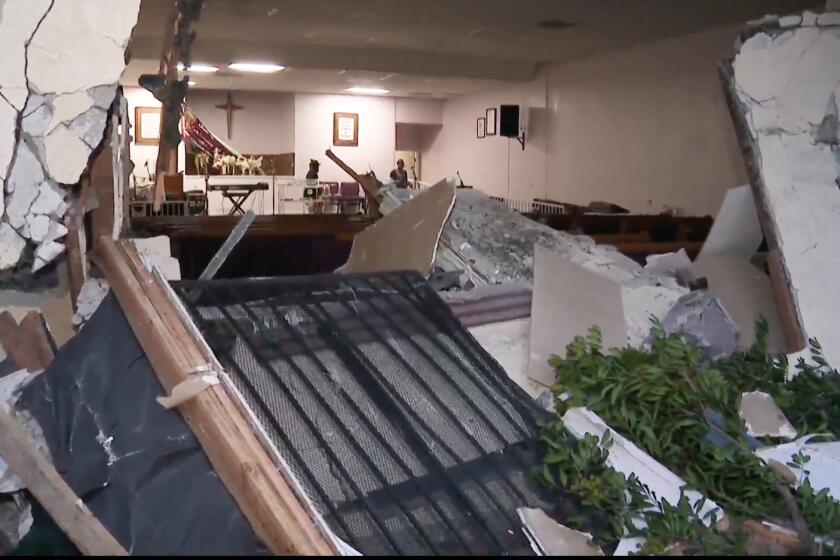Sure, San Francisco is good at bad-mouthing L.A., but they’ve been at it for more that 100 years
In quoting the other day from the New York journalist Charles Nordhoff’s 1873 book on California I observed that he evidently had not ventured to Los Angeles.
“It was then a rough, rowdy cow town,” I noted, “in which, only two years before Nordhoff’s trip (to California), the local yahoos massacred 19 Chinese in a Chinatown orgy. It was not until 1876 that the San Francisco-Los Angeles railroad was (completed). . . .”
I had only an excerpt, not the whole book, and I am informed by my more erudite readers that Nordhoff not only visited Los Angeles but wrote about it with more warmth than most New York journalists have since.
Hugh W. Berkley of Riverside and an anonymous M. J., of Santa Monica, have sent me copies of a chapter called “A January Day in Los Angeles.”
Nordhoff wrote of riding out of Los Angeles on “a cloudless, warm, sunny day,” and meeting a farmer coming into town. He was astonished to see the farmer’s wagon full of oranges, pumpkins, a lamb, corn, green peas, sugar cane, lemons and strawberries.
“Below us, as we looked off a hilltop,” he said, “lay the suburbs of Los Angeles, green with the deep green of orange groves, and golden to the nearer view with their abundant fruit.”
He said he saw a garden in the town with 21 different kinds of flowers in bloom, including the tuberose, the Jessamine, stock or gillyflower, and heliotrope trained over piazzas to the height of 20 feet.
He noted that the Pueblo de Los Angeles was “not a very angelic place.” But he saw one building, at the end of the main street, which was “both for size and excellence of architecture, worthy of San Francisco or New York.”
That must have been the Pico House, the town’s first three-story masonry building, which was built in 1868 by Pio Pico and which still stands today on Main Street just south of the Plaza.
Later, speaking specifically of the Pico House, Nordhoff observed that, like most Southern California architecture, it was designed without respect for wintry blasts. “You must walk across an open, brick-paved court, containing a fountain and flowers, to get from your room to the dining room.”
Such exposure to the weather would be unthinkable in New York, of course, and not very pleasant in San Francisco.
“If you walk down this street,” Nordhoff wrote of Main Street, “you will be surprised at the excellence of some of the shops . . . and will see abundant signs of a real and well-founded prosperity, which will surprise you if you have listened to the opinions of San Franciscans about this metropolis of Southern California. . . .”
So more than a century ago San Franciscans were already bad-mouthing L.A.
Nordhoff pointed out that even in 1873 Los Angeles had its problems with migrants. After the Civil War, the city attracted many Southerners, and especially a wave of “migratory Southern poor whites” known as “Pikes.”
While Nordhoff found many Pikes kind and hospitable, if rough in speech, they were in general regarded as lazy, mean, untrustworthy and litigious.
A lawyer described the typical Pike for Nordhoff: “He owns a rifle, a lot of children and dogs, a wife, and if he can read, a law book; he moves from place to place, as the humor seizes him, and is generally an injury to his neighbors. He will not work regularly; but he has great tenacity of life, and is always ready for a lawsuit.”
A gentleman complained to Nordhoff: “I found a Pike the other day killing and salting hogs, and actually hauling the salt pork off to sell it.”
Nordhoff responded: “Certainly that was an industrious Pike.”
“Yes,” said the gentleman, “but, confound it, they were my hogs.”
I have no doubt that many of our best families are descendants of Pikes.
Oddly, these migrant Southerners regarded the immigrant Chinese as “cheap labor” and their natural enemies.
“He does little work himself,” Nordhoff said, “and naturally he hates the patient industry of the Chinese. . . . The Chinese exact just as high wages as anybody else; but they work steadily, and do not go off at five minutes’ notice, or get drunk two or three times a week.”
(By the way, Manette G. Walker of Upland points out that in identifying Nordhoff as the grandfather of Charles Bernard Nordhoff, author of “Mutiny on the Bounty,” I neglected to note that James Norman Hall was the co-author of that book.)
Meanwhile, Henry G. Kucera of Glendale recalls a long-forgotten put-down of Los Angeles that I am glad to add to my collection. It was written by columnist Sidney J. Harris in 1953 and is a typical example of the genre.
He said: “The folks who like Los Angeles (it hardly needs to be said that I am not one of them) think San Francisco is a kind of dirty, seedy, run-down, foggy city. The San Francisco aficionados, on the other hand, consider L.A. to be phony, cheap, tawdry and completely hickish.
“All the people I like--temperamentally and intellectually--are wild about San Francisco. The Los Angeles fans are rarely interested in anything but gin rummy and the weather. . . .
“The Los Angeles barbarian enjoys the insipidity of L.A. climate, the spurious excitement of the movie colony, and the long periods of torpidity that characterize a manic-depressive city such as Hollywood.
“They want mink-lined swimming pools and bastardized Spanish architecture, flood-lighted premieres and the neurotic restlessness that makes divorce as common and casual as jaywalking. . . .”
Gin rummy, anyone?
More to Read
Start your day right
Sign up for Essential California for news, features and recommendations from the L.A. Times and beyond in your inbox six days a week.
You may occasionally receive promotional content from the Los Angeles Times.






